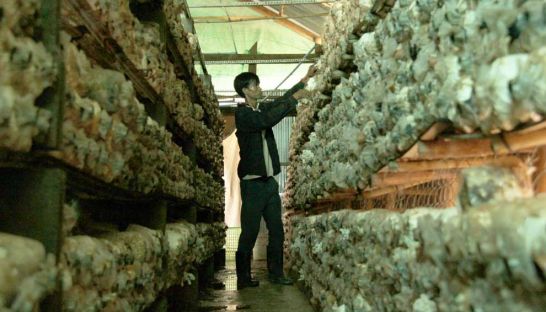Growing into the mushroom market
Growing into the mushroom market
The early days were tough going for Kim Puthkiri and his mushrooms.

In 2010, Puthkiri inherited a 5,000-square-metre mushroom farm on the outskirts of Phnom Penh from his brother, who had been trained in South Korea in the art of raising the broad-topped oyster variety, a popular Chinese soup ingredient.
New to mushroom farming, Puthkiri wanted to diversify his produce, and raise the more dense straw mushroom, a bulbous fungus with greater appeal in Cambodian cuisine.
“We successfully grew oyster mushrooms, but Cambodian people do not like to eat oyster mushrooms, they prefer straw mushrooms. So we started to grow straw mushrooms when we did not even have the technique,” he said.
An attempt to recruit an agricultural professional claiming to be a straw mushroom expert failed to kick start his new venture. In just over a year Puthkiri had acquired 10 mushroom houses, mounting debts, but still no straw mushrooms.
“More than $40,000 was spent building mushroom houses. Raw materials were gone, the staff was hopeless,” he explained.
“It came to me that if I want to be a success in this business, I will have to be an expert myself. I talked to my wife, and then sent her to study about mushrooms in Thailand.”
And the training was effective. While Puthkiri looks after marketing and sales, his wife Vireak Daliss, provides the technical advice, and three years on, they have built up two oyster mushroom growing houses and 17 straw mushroom growing houses, that combined, produce more than 3,000 kilograms of fungus each month.
“I have heard a lot about farmers failing in growing straw mushrooms. I too was a failure in [the] straw mushroom business – the biggest loser in Cambodia – but I also want to be the most successful person [in] this business in Cambodia. I see lots of opportunities for this straw mushroom business,” Puthkiri said.
Puthkiri’s mushrooms are sold to Cambodian restaurants and organic vegetable stores run by the Cambodia Center for Study and Development in Agriculture (CEDAC). And just recently, Puthkiri signed a contract to supply 50 kilograms of mushroom per day to a Japanese food distributor servicing Japanese restaurants in Cambodia.
And the expansion plans do not end there.
“Farmers can get mushroom spawn from our farm to grow, then they can sell it back to me, then I export,” he said referring a mushroom extract injected in to grain and used to reproduce the fungi. “This way, farmers will be better off by doing farming and at the same time growing mushrooms,” he said.
But there are still challenges to overcome. Official data are difficult to come by, but the government estimates that about 60 per cent of Cambodia’s vegetable supplies are imported from Vietnam where farmers are able to produce higher yields at lower costs.
“It’s hard for our farmers to sell their locally produced vegetable at a competitive price compared to our neighbouring countries due to the lack of farming techniques and higher production costs,” Som Loun, deputy director of the Department of Horticulture and Subsidiary Crops, as the cost of production and competition from neighbouring Vietnam.
Despite the hurdles, Loun is encouraged by pioneers in the agriculture sector and is welcoming of Puthkiri’s locally grown product.
“It’s good for farmers when they have specific markets, they will try to produce more, and having a leader will help facilitate connecting the market with traders,” he said.
Yang Saing Komar, director of the Cambodian Center for Study and Development in Agriculture said mushroom growing is still in it’s infancy in Cambodia, and it is very difficult to attract local producers to take it up as it requires delicate techniques and special care.
“The market for mushrooms is big due to limited supply. If they can keep the cost of production a bit lower, they will be able to compete with imported mushrooms,” he said.
Growing mushrooms is an intricate process for beginners according to Puthkiri. Mushroom spawn is combined with organic material such as straw or saw dust, and then layered in a tray before covering with moss, to keep the fungi moist. Puthkiri says it takes around 30 to 45 days before the mushrooms can be harvested.
Temperature too is critical in achieving the greatest yields, and Puthkiri plans to import technology from Thailand to help control his growing environment as soon as his monthly harvest is large enough to fund the upgrade.
“My plan is to become the biggest mushroom distributor in Cambodia, for local markets and also for exports. We are not planting mushrooms, but diamonds, I often tell my staff,”
phnompenh post













